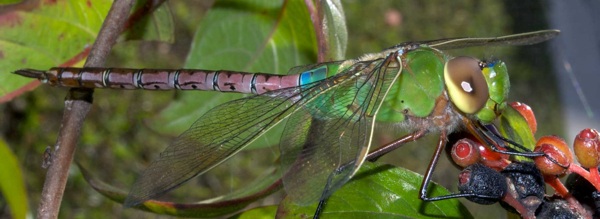
Nutrition
 Anax junius migrates south during
seasons. The Common Green Darner is always in a warm habitat.
Therefore, temperature dictates were this species migrates to (EOL).
Anax junius is a predaceous species as both adults and
larva. The Common Green Darner eats insects including
mosquitoes, wasps, butterflies, and even other dragonflies. They
control the populations of the different insect species.
According to Nature Serve Explorer, there have been reported
cases that the Common Green Darner has attacked hummingbirds and
at times, can be cannibalistic (NatureServe 2011). The naiads, larvae of Anax junius,
consume oligochaete worms, crustaceans, small fish, gastropods,
tadpoles, and possibly their own species (O'Toole
2002).
Anax junius migrates south during
seasons. The Common Green Darner is always in a warm habitat.
Therefore, temperature dictates were this species migrates to (EOL).
Anax junius is a predaceous species as both adults and
larva. The Common Green Darner eats insects including
mosquitoes, wasps, butterflies, and even other dragonflies. They
control the populations of the different insect species.
According to Nature Serve Explorer, there have been reported
cases that the Common Green Darner has attacked hummingbirds and
at times, can be cannibalistic (NatureServe 2011). The naiads, larvae of Anax junius,
consume oligochaete worms, crustaceans, small fish, gastropods,
tadpoles, and possibly their own species (O'Toole
2002).
In order to capture food, the larva, or naiad,
shoot out their jaws and grab a hold their prey. The Common Darner dragonfly larva
shoots out its labium, that is filled with hooks, to grasp their
prey (O'Toole 2002). The labium is pulled back to their mouth and the dragonfly larva begins to chew
their prey, which is known as mechanical digestion (O'Toole
2002). Metamorphosis is the process of maturation of the larva
into an adult. Adult dragonflies are able to grasp their prey with their
legs or scoop them up by their wings. Adults also possess a labium.
After the labium shoots out and brings the prey towards their mouth,
the dragonfly then removes the nutrients from its prey (Hickman et al. 2007).
These nutrients need to be broken down for use of energy by the
body. The dragonfly has a complete digestive system consisting of
both a mouth and an anus, salivary glands, esophagus, crop with is
used for storage and a proventriculus which is used for grinding, a
midgut, and a hundgut (Hickman
et al. 2007).
pulled back to their mouth and the dragonfly larva begins to chew
their prey, which is known as mechanical digestion (O'Toole
2002). Metamorphosis is the process of maturation of the larva
into an adult. Adult dragonflies are able to grasp their prey with their
legs or scoop them up by their wings. Adults also possess a labium.
After the labium shoots out and brings the prey towards their mouth,
the dragonfly then removes the nutrients from its prey (Hickman et al. 2007).
These nutrients need to be broken down for use of energy by the
body. The dragonfly has a complete digestive system consisting of
both a mouth and an anus, salivary glands, esophagus, crop with is
used for storage and a proventriculus which is used for grinding, a
midgut, and a hundgut (Hickman
et al. 2007).
Oxygen in adult dragonflies are carried out by a tracheal system. The tracheal system carries the oxygen to parts of the body through tubes. The anus of the larvae of the Anax junius consists of tracheal gills. These gills breathe by means of oxygen exchange of water through the anus. This means of oxygen exchange in the naiads also provides locomotion known as jet propulsion through the water (O'Toole 2002).
For more information about the feeding habits of Anax junius, please visit Introduction to the Odonata.
Next explore the
Reproduction of the Anax junius
Return to the Homepage